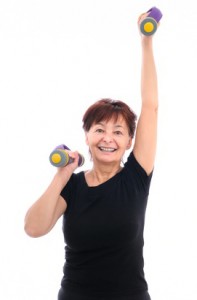After Breast Cancer, Get a Gym Membership!
Earlier this month the Journal of the American Medical Association (JAMA) published a myth-busting paper on weight lifting for women at risk for lymphedema after breast cancer treatment. The study was neither large (154 patients at max, whittled down to 134 at analysis) nor high-tech (interventions involved gym memberships, weight training and lifting in neighborhood facilities like YMCAs).
The results were clear: working out with hand-held weights, carefully, is good for most women who’ve had surgery for breast cancer (BC).
Lymphedema, or swelling due to a damaged gland, can develop in a patient’s arm after removal of lymph nodes in the armpit. The uncomfortable condition can be disabling by impairing arm or hand movements. It affects a significant number of BC patients: among women who’ve had have just a sentinel lymph node removed, lymphedema affects roughly 6%; for those who’ve had complete axillary (armpit) lymph node dissection, the incidence is around 30%. There are roughly 2.5 million women living in the U.S. after a breast cancer diagnosis; most are at elevated risk for lymphedema.
Years ago, doctors commonly advised patients not to lift weights or perform strenuous exercises with their arms after a mastectomy or lumpectomy with lymph node dissection. To a lesser extent, this happens still today. As reported in the JAMA article:
Breast cancer survivors at risk for lymphedema alter activity, limit activity, or both from fear and uncertainty about their personal risk level, and upon guidance advising them to avoid lifting children, heavy bags, or other objects with the at-risk arm.9,10 Such guidance that deconditions the arm, increasing the potential for injury, overuse, and, ironically, lymphedema onset.11 Adherence to these precautions may limit physical recovery after breast cancer and, for some women, result in lost employment. Furthermore, activity avoidance may deter survivors from performing regular exercise…
The researchers recruited women in the Philadelphia area who’d undergone surgery for localized, unilateral breast cancer sometime between 1 and 5 years before the study. Each had at least 2 lymph nodes removed in surgery. The median age was around 55 years. The women were divided into two balanced groups before randomization – they received a year’s membership at a gym and a trainer for the first 13 weeks, or not.
So it’s good news that the women in “weight lifting intervention” group developed less lymphedema. What’s more, those women became stronger and sported a lower percentage of body fat. All of these differences were statistically meaningful and, for the most part, quite strong. Perhaps more remarkably, in a pre-planned subset analysis of women who’d had 5 or more lymph nodes removed, the proportion who experienced lymphedema in the weight-lifting group was only 7%, compared with 22% in the controls. That difference was highly significant, with a p-value of 0.003. The findings, in sum, show that it’s safe for women who’ve had breast cancer surgery to work out in a way that includes a careful, progressive upper body strengthening.
About a week ago, I was alerted to this article by Dr. Ramona Bates, a plastic surgeon who authors Suture for a Living. She’s had several recent, excellent pieces on this subject including a post on lymphedema and the JAMA report. I chose to write on this, in part, because it meshes with my professional and medical history.
In my case, I got conflicting advice on the matter. I wanted to continue swimming because it helps my scoliotic back. But some colleagues suggested that arm-intense strokes might be best avoided after mastectomies. A cosmetic surgeon rightly told me that some strokes might have untoward effects on implants. So I relied on my judgment: I chose to swim because it made me feel better and stronger. In the past year, I’ve started lifting a few small weights, carefully and slowly.
In the end, this is a story of a small clinical trial and the value of common sense in medicine. Weight lifting is not only safe; it can reduce the incidence of lymphedema in women at risk. But “old wives’ tales” still persist in some doctors’ minds; these need be dispelled. Finally, I can’t help but wonder what would happen if every woman could have a year’s membership at a local gym –
—-
That’s a relief. I’ve recently taken up canoeing and was slightly concerned about any possible effects. But so far so good. I don’t push things, and honestly it feels very good to exercise the arm a little.